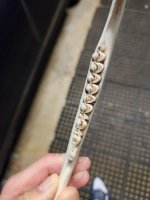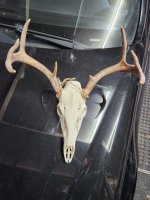You are using an out of date browser. It may not display this or other websites correctly.
You should upgrade or use an alternative browser.
You should upgrade or use an alternative browser.
Whitetail aging expert anyone?
- Thread starter Spcamno
- Start date
fingers284
CGN Ultra frequent flyer
- Location
- Alberta Cowboy Ranges
Wont be able to tell just by looking at the teeth, game branch cuts teeth in half and counts "growth rings same as a tree to ascertain age.
By the horn photo I would say less than 3
By the horn photo I would say less than 3
Shedmaster
Member
- Location
- ne Alberta
Also antler shape and size is not totally indicative to age. Genetics with antler style and size is all over. That could be a six year old ( scrub buck) or a 2.5 year old up and comer. My bet he’s older than 3.5 with poor genetics for larger antlers.
The only truly accurate way I’m aware of is to section the teeth and count growth rings. You can get pretty close by judging tooth wear but you have to be careful comparing to charts and photos as different browse will cause different wear. In the forest where I hunt whitetail they show excessive wear for their age, I’m assuming from eating woody browse more than farmland deer. A deer that was shot in the area I hunt was judged as an 8 1/2yr old going off a chart but from years of trail cam pics and previous years sheds from that buck I was about 90% sure he was only 6 1/2. If he was 8 1/2 then I’ve shot a lot of 8 1/2 yr old deer up there as well as several that would have to be 9 and 10 yr old, which isn’t very likely
Last edited:
The only truly accurate way I’m aware of is to section the teeth and count growth rings. You can get pretty close by judging tooth wear but you have to be careful comparing to charts and photos as different browse will cause different wear. In the forest where I hunt whitetail they show excessive wear for their age, I’m assuming from eating woody browse more than farmland deer. A deer that was shot in the area I hunt was judged as an 8 1/2yr old going off a chart but from years of trail cam pics and previous years sheds from that buck I was about 90% sure he was only 6 1/2. If he was 8 1/2 then I’ve shot a lot of 8 1/2 yr old deer up there as well as several that would have to be 9 and 10 yr old, which isn’t very likely
This.
Cementum Annuli is the most proven way. Antler characteristics etc can vary widely.
I should have added this to my previous comment:
This skull is quite narrow along with a very narrow nasal ridge and no extra bumps or density indicative of any sparring or big fights, so just further support for a very young deer.
This skull is quite narrow along with a very narrow nasal ridge and no extra bumps or density indicative of any sparring or big fights, so just further support for a very young deer.











































































